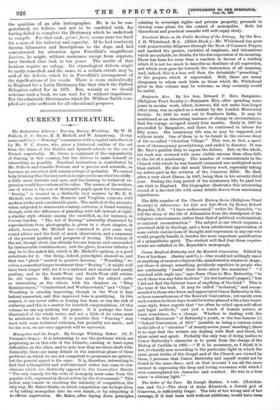CURRENT LITERATURE.
The Badminton Library : Fencing, Boxing, Wrestling. By W. H. Pollock, F. C. Grove, E. B. Michell, and W. Armstrong. (Long- mans and Co.)—" Fencing" commences with a capital introduction by Mr. F. C. Grove, who gives a historical outline of the art from the times of the Italian and Spanish schools to the era of French superiority. Mr. Grove is cognisant of the unpopularity of fencing in this country, but has striven to make himself as interesting as possible. Practical instruction is contributed by Mr. Pollock and Camille Prevost, and is precise and scientific, as becomes an art which still retains a tinge of pedantry. We cannot help thinking that the instruction is expressed somewhat too stiffly : a little more latitude and ease, and less leaning to technical ex- pression would have enhanced its value. The names of the writers, one of whom is the son of Bertrand's pupil, speak for themselves. " Boxing " is treated in a distinctly racy manner by Mr. E. B. Michell, who recounts the Homeric and Virgilian contests with modern asides and considerable gusto. The method of the ancients, when subjected to nineteenth-century criticism, is found wanting, though, with the difference of guarding with left instead of right, a similar style obtains among the unskilled, as, for instance, in Covent Garden. " The Art of Boxing," admirably illustrated by reproductions from photographs, is given in a short chapter, in which, however, Mr. Michell has contrived to give some very sound advice and the fruit of much observation, and a summary of the present position and prospects of boxing. The history of the art, though short, has already become famous and surrounded by innumerable reminiscences ; and the glove, however inferior it may be to the naked fist, which is Mr. Michell's opinion, is a good substitute for it. One thing, indeed, prize-fights showed us, and that was " pluck " carried to positive heroism. " Wrestling " re- ceives a somewhat longer treatment than " Boxing " ; it might well have been longer still, for it is a national and ancient and manly pastime, and in the South-West and North-West still retains its old vigour. Mr. Armstrong has made his subject quite as interesting as the others, with his chapters on " Ring Reminiscences," "Cumberland and Westmoreland," and "Chips." Wrestling is steadily improving, though in the West it lags behind somewhat, and this improved tone is gratifying. In this respect, it can never suffer as boxing has done, or run the risk of outlawry, and this is a matter for heartfelt congratulation. Of this volume we can say nothing but praise. It is perhaps the best- illustrated of the whole series, and not a little of its value must be attributed to this fact. It is possible that " Fencing" may meet with some technical criticism, but probably not much ; and for the rest, we are sure approval will be universal.


















































 Previous page
Previous page